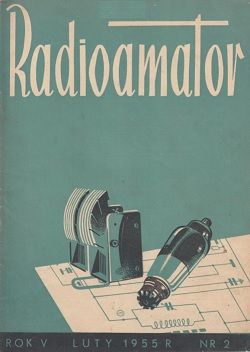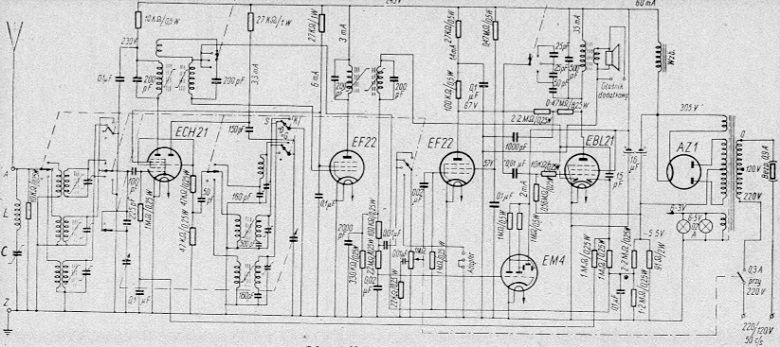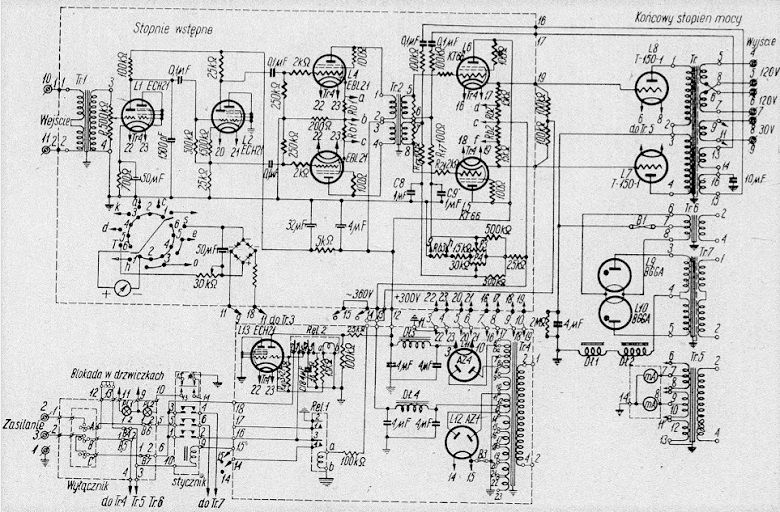
- ON THE SOCIAL CHARACTER OF RADIO-AMATEUR WORK (1)
"PEOPLE'S POLAND has created the best conditions for the development of the amateur radio movement. It also surrounds - on a par with other branches of technology or science - with caring care, sparing no support and resources for the widest possible massization of radio amateur creativity and constantly raising it to a higher and higher ideological and technical level..." - INTERNATIONAL RADIO-TELEGRAPHIC COMPETITION IN LENINGRAD - M. Konieczny (3)
"ACCORDING to the announcement in the January issue of RADIOAMATOR, we provide further details on the International Radiotelegraph Competition, which took place in Leningrad from November 18 to 28, 1954..." - THE ESSENCE OF ELECTROMAGNETIC WAVES - M. R. (5)
"For those learning the basics of radio technology, the greatest difficulty is usually to understand the essence of radio waves, and in general the essence of electromagnetic waves. It is understandable, taking into account that radio waves - without affecting our senses directly - are imperceptible, imperceptible by us. In addition, the radio engineering section devoted to the essence of radio waves is generally not dealt with exhaustively in textbooks..." - HIGH FREQUENCY INDUCTORS - mgr inż. K. Lewiński (7)
"If high-frequency chokes have almost completely disappeared from radio receivers, they are still widely used in radio transmitting equipment. The main place of work of RF reactors is the anode circuit of the RF power amplifier, as well as their grid circuit..." - AMATEUR TAPE RECORDERS HEADS - inż. A. OWCZAREK (10)
"HEADS are among the most sensitive and essential elements of a tape recorder. They represent an electromagnet with a core made of iron-nickel alloy plates with high magnetic permeability and low coercivity. The core consists of symmetrical halves; each of them has a coil in half winding..." - DESIGNING A DIRECTIONAL VHF ANTENNA (part I) - mgr inż. Z. Kachlicki (14)
"WORK in the field of VHF creates an opportunity, among others also for close contact with directional antennas. The construction of such antennas for the short-wave range, although very desirable, causes considerable difficulties in amateur conditions due to their large dimensions resulting from the considerable short-wave length..." - RADIO RECEIVER "SYRENA" - A. S. (16)
"Manufactured by the domestic industry, the "Syrena" receiver is a mid-class 6-circuit superheterodyne (four intermediate frequency circuits factory tuned at 468 kHz, a single input circuit and one oscillator tuned circuit)..."

Schematic diagram of the receiver 'Syrena'
- MINIATURE BATTERY TUBES - St. Wójcik (18)
"Battery receivers mounted on miniature tubes (often called "finger tubes") are very popular among our radio amateurs. Therefore, we give a few remarks on the electrical data, socket layouts and their equivalent tubes..." - RADIO NODE POWER AMPLIFIER WR-600 - inż. A. Witort (20)
"Manufactured by the domestic telecommunication industry, the WR-600 type power amplifier is designed for medium and high power radio hubs. In addition, it is sometimes used in local radio nodes, serving large industrial plants. The schematic diagram of the amplifier is shown in the figure. The symmetrical transformer input is adapted to be connected with a control amplifier, a control receiver or a wire track. The first stage is a voltage amplifier. The second stage serves as a phase inverter and controls the third stage operating in a push-pull mode on two EBL21 tubes. The fourth stage is used to obtain the power necessary to control the final stage tubes. This stage works in the cathode follower system, with the cathodes of KT66 tubes connected directly with the grids of the final stage tubes. 6L6 or 6P3 tubes can be used instead of KT66 tubes. The end stage with two T-150-1 tubes has an output transformer to which the load is connected to the secondary windings..."

Schematic diagram of the WR-600 amplifier
- FROM RADIO AMATEURS PRACTICE (23)
"Electricity meter as a wattmeter.
Improved method of detecting unmodulated telegraphy in superheterodyne.
A new method of supplying the screening grid for anodic modulation of beam tetrodes
Short-wave transmitting and receiving devices in cable cars.
Transmitters in steam locomotives." - IN THE EXPERIMENTAL CENTER OF POLISH TELEVISION - T. Pszczółkowski (26)
"From September 10, 1954, the Experimental Television Center in Warsaw broadcasts its program every Friday at 5:00 pm ..." - CHARACTERISTICS OF ELECTRON TUBES - inż. M. Flisak (27)
"Guided by the many wishes of our readers, expressed in the survey conducted last year and in numerous correspondence, we are introducing a new section "Characteristics of tubes". Characteristics and comprehensive data concerning the most common tubes on our market will be given here..." - RESULTS OF THE THIRD INTERNATIONAL SHORT WAVE COMPETITION (29)
"We present the results of the International Shortwave Competition, organized by the Central Communications Club of the League of Friends of the Soldier to celebrate the 10th anniversary of People's Poland and the Polish Army Day..." - EXCHANGE (31)
- NOMOGRAM: INDUCTION, CAPACITIVE RESISTANCE, RESONANCE FREQUENCY (32)
"We present here nomograms with which you can quickly determine the inductive resistance at a given inductance L, capacitive resistance and resonant frequency..." - DO YOU KNOW THAT... (IV)
"...Czechoslovak radio amateurs have achieved the world record for two-way communication in the 1215 MHz band ...
The most accurate devices for transmitting time signals are equipped with quartz clocks controlled by an astronomical observatory ...
Radio astronomy deals with, among others studying the variability of the intensity of radio radiation coming to us from different parts of the universe..."
PDF : Radioamator 1955/02 v1




Comments powered by CComment